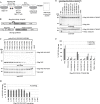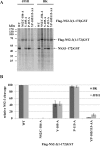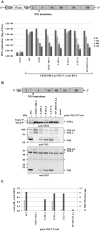A conserved NS3 surface patch orchestrates NS2 protease stimulation, NS5A hyperphosphorylation and HCV genome replication
- PMID: 25774920
- PMCID: PMC4361677
- DOI: 10.1371/journal.ppat.1004736
A conserved NS3 surface patch orchestrates NS2 protease stimulation, NS5A hyperphosphorylation and HCV genome replication
Erratum in
-
Correction: A Conserved NS3 Surface Patch Orchestrates NS2 Protease Stimulation, NS5A Hyperphosphorylation and HCV Genome Replication.PLoS Pathog. 2016 Jan 8;12(1):e1005394. doi: 10.1371/journal.ppat.1005394. eCollection 2016 Jan. PLoS Pathog. 2016. PMID: 26745726 Free PMC article.
Abstract
Hepatitis C virus (HCV) infection is a leading cause of liver disease worldwide. The HCV RNA genome is translated into a single polyprotein. Most of the cleavage sites in the non-structural (NS) polyprotein region are processed by the NS3/NS4A serine protease. The vital NS2-NS3 cleavage is catalyzed by the NS2 autoprotease. For efficient processing at the NS2/NS3 site, the NS2 cysteine protease depends on the NS3 serine protease domain. Despite its importance for the viral life cycle, the molecular details of the NS2 autoprotease activation by NS3 are poorly understood. Here, we report the identification of a conserved hydrophobic NS3 surface patch that is essential for NS2 protease activation. One residue within this surface region is also critical for RNA replication and NS5A hyperphosphorylation, two processes known to depend on functional replicase assembly. This dual function of the NS3 surface patch prompted us to reinvestigate the impact of the NS2-NS3 cleavage on NS5A hyperphosphorylation. Interestingly, NS2-NS3 cleavage turned out to be a prerequisite for NS5A hyperphosphorylation, indicating that this cleavage has to occur prior to replicase assembly. Based on our data, we propose a sequential cascade of molecular events: in uncleaved NS2-NS3, the hydrophobic NS3 surface patch promotes NS2 protease stimulation; upon NS2-NS3 cleavage, this surface region becomes available for functional replicase assembly. This model explains why efficient NS2-3 cleavage is pivotal for HCV RNA replication. According to our model, the hydrophobic surface patch on NS3 represents a module critically involved in the temporal coordination of HCV replicase assembly.
Conflict of interest statement
The authors have declared that no competing interests exist.
Figures







Similar articles
-
Sequential Phosphorylation of the Hepatitis C Virus NS5A Protein Depends on NS3-Mediated Autocleavage between NS3 and NS4A.J Virol. 2020 Sep 15;94(19):e00420-20. doi: 10.1128/JVI.00420-20. Print 2020 Sep 15. J Virol. 2020. PMID: 32699091 Free PMC article.
-
Packaging defects in pestiviral NS4A can be compensated by mutations in NS2 and NS3.J Virol. 2023 Sep 28;97(9):e0057223. doi: 10.1128/jvi.00572-23. Epub 2023 Sep 11. J Virol. 2023. PMID: 37695056 Free PMC article.
-
A positive-strand RNA virus uses alternative protein-protein interactions within a viral protease/cofactor complex to switch between RNA replication and virion morphogenesis.PLoS Pathog. 2017 Feb 2;13(2):e1006134. doi: 10.1371/journal.ppat.1006134. eCollection 2017 Feb. PLoS Pathog. 2017. PMID: 28151973 Free PMC article.
-
The hepatitis C virus NS2/3 protease.Curr Issues Mol Biol. 2007 Jan;9(1):63-9. Curr Issues Mol Biol. 2007. PMID: 17263146 Review.
-
The nonstructural proteins of the hepatitis C virus: structure and functions.Biol Chem. 1997 Jun;378(6):469-76. Biol Chem. 1997. PMID: 9224925 Review.
Cited by
-
Studies on the selectivity of the SARS-CoV-2 papain-like protease reveal the importance of the P2' proline of the viral polyprotein.RSC Chem Biol. 2023 Oct 24;5(2):117-130. doi: 10.1039/d3cb00128h. eCollection 2024 Feb 7. RSC Chem Biol. 2023. PMID: 38333195 Free PMC article.
-
Impact of novel NS5A resistance-associated substitutions of hepatitis C virus detected in treatment-experienced patients.Sci Rep. 2019 Apr 5;9(1):5722. doi: 10.1038/s41598-019-42114-z. Sci Rep. 2019. PMID: 30952914 Free PMC article.
-
CRISPR/Cas9-Mediated Knockout of DNAJC14 Verifies This Chaperone as a Pivotal Host Factor for RNA Replication of Pestiviruses.J Virol. 2019 Feb 19;93(5):e01714-18. doi: 10.1128/JVI.01714-18. Print 2019 Mar 1. J Virol. 2019. PMID: 30518653 Free PMC article.
-
Identification of NS2 determinants stimulating intrinsic HCV NS2 protease activity.PLoS Pathog. 2022 Jun 21;18(6):e1010644. doi: 10.1371/journal.ppat.1010644. eCollection 2022 Jun. PLoS Pathog. 2022. PMID: 35727826 Free PMC article.
-
Hepatitis C virus NS3 helicase contributes to (-) strand RNA synthesis.Nat Commun. 2025 Aug 27;16(1):8006. doi: 10.1038/s41467-025-63498-9. Nat Commun. 2025. PMID: 40866424 Free PMC article.
References
Publication types
MeSH terms
Substances
Grants and funding
LinkOut - more resources
Full Text Sources
Other Literature Sources
Miscellaneous

